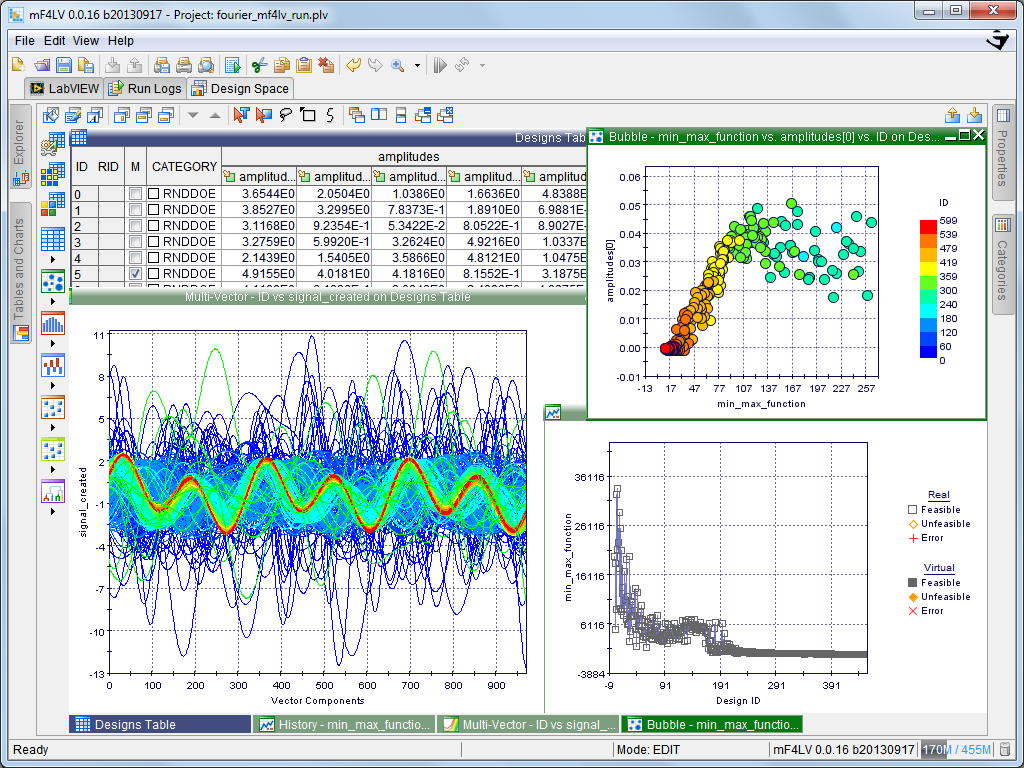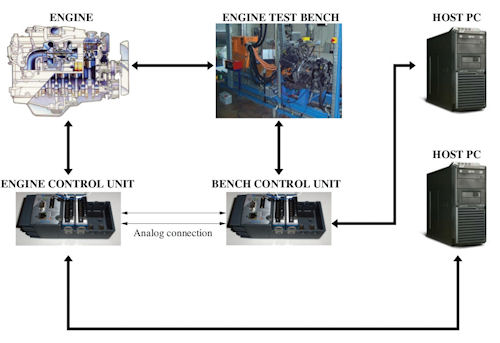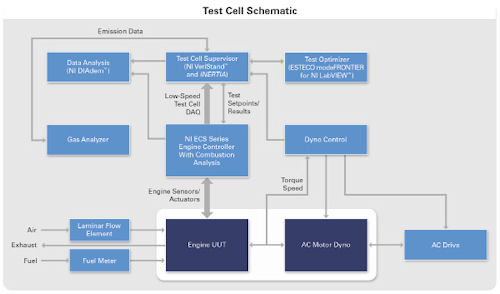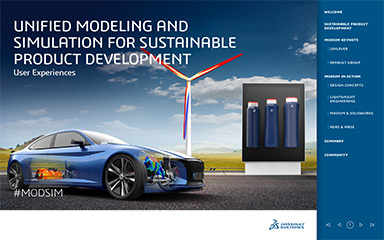
mF4LV lets LabVIEW users improve product performance and reduce testing time via its HIL optimization capabilities. Image courtesy of ESTECO
Latest News
March 29, 2014
 mF4LV lets LabVIEW users improve product performance and reduce testing time via its HIL optimization capabilities. Image courtesy of ESTECO
mF4LV lets LabVIEW users improve product performance and reduce testing time via its HIL optimization capabilities. Image courtesy of ESTECOIn light of the next generation of more rigorous emissions standards, the automotive supply chain is facing a tricky dilemma: How to throttle up complex testing on powertrain and engine control units, without casting undue drag on test cycles or performance.
It’s been quite a balancing act for Alma Automotive, whose core business is providing hardware and software-based custom solutions dedicated to engine control, diagnosis and testing for such high-profile customers like Ferrari, Ducati and Lamborghini. Founded in 2003 by researchers from the Department of Mechanical and Energetic Engineering at the University of Bologna, the company focuses its testing services in three areas: real-time combustion analysis, hardware-in-the-loop (HIL) systems and rapid control prototyping.
Given its customers’ penchant for speed for both engine performance and steering high-octane sports car and motorcycles to market, Alma Automotive was in search of new practices that could turbocharge its engine control unit (ECU) test bed, specifically as it relates to calibration. Its typical process was slow and cumbersome, requiring test engineers to painstakingly make manual adjustments to parameters using the engine test bench, which was instrumented with hardware and software from National Instruments (NI). The primary challenge was to achieve optimum parameter results as quickly as possible while maximizing system accuracy—a scenario that was increasingly difficult to achieve with the manual test process.
A solution came via a collaborative effort among Alma Automotive, NI and ESTECO, a maker of the modeFRONTIER multi-disciplinary and -objective optimization platform. The trio partnered to create a direct integration between LabVIEW, NI’s graphical system design software used by Alma Automotive to design its ECU test bench, and modeFRONTIER. The result enables modeFRONTIER’s process integration and optimization capabilities to be deployed on the ECU’s HIL testing, automating the search for optimum parameter results—and in the end, driving significant efficiencies throughout the test process.
“Our customers’ target is to optimize engine performance. They need to change the control parameters in order to achieve something that could be the optimal power or minimum fuel consumption,” explains Enrico Corti, one of the founders of Alma Automotive. “But they need a guide for which direction to move the control parameters in to minimize or maximize their cause. We wanted to add real-time optimization to our systems; that’s why we thought of using modeFRONTIER and integrating it with LabVIEW.”
Complex DOE
The trio embarked on a project to demonstrate the value of combining the NI test and measurement devices with a modeFRONTIER framework, leveraging specific applications developed by Alma Automotive for the engine setup. The result of their efforts is modeFRONTIER for LabVIEW (mF4LV), a light, add-on version of the process automation and optimization platform. It’s specifically integrated with LabVIEW with the goal of helping engineers and scientists quickly reach a sought-after response from the hardware or control systems they have under test.
By exploiting modeFRONTIER’s advanced optimization algorithms, mF4LV significantly speeds up HIL testing by automatically modifying the values assigned to control parameters. This helps to achieve optimal hardware behavior in lieu of relying on humans to manually make the adjustments.
Dr. Matt Viele, principal architect for NI’s Powertrain Controls Group, says modeFRONTIER’s process automation and optimization capabilities are a key asset in helping automotive powertrain groups accelerate the increasingly complex design of experiment required to accommodate modern engine design for current and future fuel emissions standards.
“The modern engine now has between six and seven actuators, and maybe 12 degrees of freedom in the system, which means it would take decades to run through calibrations with a brute force method,” Viele explains. “That just isn’t practical. Something like modeFRONTIER is required to choose battles when going through this kind of optimization.”
 Alma Automotive set up a test environment for the automatic calibration system, consisting of engine and test bench controllers based on NI CompactRIO devices. Image courtesy of ESTECO.
Alma Automotive set up a test environment for the automatic calibration system, consisting of engine and test bench controllers based on NI CompactRIO devices. Image courtesy of ESTECO.Viele says that when setting up ECU design of experiments (DOE), it isn’t possible to cover all corners of the test matrix with manual processes. That’s where an optimizer like modeFRONTIER comes in. “You need a more advanced algorithm and an iterative approach, like what can be delivered by an optimization tool,” he adds. “The hope is that in the course of a few hundred or thousand test points, you can get the map 99% of the way there—as opposed to the billion test points that you would have to create manually without the help of automation or optimization.”
NI opted to partner with ESTECO on the project rather than try to build its own test optimizer technology because the area isn’t the company’s strong suit. mF4LV is sold on NI’s LabVIEW Tools Network.
“We know how to build a great test system and great test hardware, but we are not great DOE people. ESTECO is,” Viele says.
mF4LV’s direct integration with LabVIEW makes it easier for LabVIEW users to take advantage of modeFRONTIER’s optimization capabilities. While the two could be used together previously as part of modeFRONTIER’s node architecture, mF4LV has a customized graphical user interface (GUI) that makes it look and feel like LabVIEW. This way, users are neither required to learn a new environment nor encumbered with modeFRONTIER capabilities that aren’t specific to the testing process.
“The integration simplifies set-up,” explains Dr. Livio Tenze, ESTECO’s head of IT. “They can set up constraints, generate random starting points, and select the optimization they’d like to use. The process is simplified, and they don’t have to learn new software.”
Alma’s Test Bench
Having optimization capabilities as part of a LabVIEW user experience is one of the primary appeals of mF4LV for Alma Automation, which is piloting the package as a way to help its customers achieve a shorter calibration period for optimal engine-under-test management. Alma Automotive set up a test environment for the automatic calibration system, consisting of engine and test bench controllers based on NI CompactRIO devices, which are programmed and equipped with field-programmable gate array (FPGA) boards. The test bench controllers are connected to the engine, as well as to the bench transducers and actuators.
 Schematic shows where modeFRONTIER for LabVIEW fits in as part of an automotive test cell. Image Courtesy of National Instruments.
Schematic shows where modeFRONTIER for LabVIEW fits in as part of an automotive test cell. Image Courtesy of National Instruments.The CompactRIO devices send signals through an Ethernet connection to two host PCs running Windows 7, which store the data and set up the operating parameters. The interfaces developed by Alma Automotive provide easy interaction with the ECU system, allowing the test-bed sensors to route signals to mF4LV, running on the host PCs, as optimization targets. From there, the optimization algorithm, in a range specified by the user, automatically chooses the parameter values and drives the transducers toward the optimal solution.
To test the ECU test bed optimization workflow, the partners set up two tests. The first was a simple test that involved finding the optimal calibration for the spark advance on a real engine, which was mounted on the test bench, to optimize the maximum brake torque.
“This is one of the most important aspects that need to be optimized,” explains Alma Automotive’s Corti. “Our objective was to maximize this parameter while maintaining the engine in safe operating conditions.”
Before the test, the team set the range of spark advance degrees on modeFRONTIER, choosing the simplex (Nelder-Mead) algorithm for maximum torque; the team reached the goal in approximately 10 optimization steps.
After successfully completing the first test, the team moved on to a more complex experiment to prove the effectiveness of the system for optimizing fuel-film automatic compensation. Typically, some of the gasoline injected into an intake manifold of a spark ignition engine collects at the bottom of the intake runner wall. After a while, depending on the temperature, the wall film evaporates and goes into the cylinder, which can cause delays in engine reaction.
The test involved using mF4LV algorithms to identify the value of the X and tau constants in real time to compensate for this fuel-film dynamics, thus preventing any engine delays. mF4LV’s automation capabilities let X and tau values be mapped and the optimal compensation strategy established, Corti says.
“To predict such a dynamic, two parameters have to be calibrated so the optimization problem has different objectives that need to be coupled in a multi-objective optimization,” he adds. “In this case, the classic approach based on measurements on a test bench, and offline analysis would be quite demanding and not always achievable. But this is modeFRONTIER’s sweet spot.”
While Alma Automotive is not yet committed to offering mF4LV as part of its ECU test bench solution, it does see a clear role for automating the optimization process around testing, depending on the specific problem. modeFRONTIER, in particular, offers some real benefits when it comes to the need to reduce test cycles.
“If you use an optimizer requiring 1,000 tests, it means you have to stay at the test bench for 20 hours,” explains Giorgio Mancini, a Ph.D. student at the University of Bologna working with Alma Automotive on this project. “The good thing with modeFRONTIER and its optimizers is they get you to close to the optimal solutions in just a few steps, reducing the time you have to stay on the bench.”
More Info
Subscribe to our FREE magazine, FREE email newsletters or both!
Latest News
About the Author
Beth Stackpole is a contributing editor to Digital Engineering. Send e-mail about this article to DE-Editors@digitaleng.news.
Follow DE





